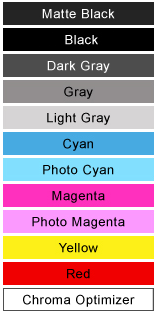Some clarifications first.
I am aware that CMYK is a Colour Gamut used for Printing
@User287001 (btw, this user should put a name behind all that knowledge) already said that it is not a gamut.
- CMYK is several things.
A. It is a Color model, generally speaking using primary subtractive colors to generate an image based on a light substrate. The K is just to add depth because the lack of perfect CMY pigments.
B. It is a color mode for a digital file, to separate the different channels containing the color information of the previous primary colors.
5+ Colours ranges.
"Range" is not a term used in this case. They are simply "inks" 5+ inks.
Nomenclatures
You probably noticed that some of those inks are in fact still CMYK ones, but lighter tones.
The first basic naming on this case is:
CcMmYK
This is a six-ink CMYK printer. With Light Cyan and Light magenta. The hue is similar but it is more transparent, so individual dots of those colors are less noticeable on the light colors.
They also can be named lc and lm.
This is by far the most commonly used on digital printers, besides a normal CMYK.
But it still uses a CMYK color mode to print. The difference is that on light CM values, the printer will fire the light versions of the ink instead of the normal ones.
CcMmYKk
Then you could add a Kk when you also have two tones of black. It can also be called gy.
This is less used because normally on a color profile the black will be fired when the color needs to be darkened beyond a certain point. A light gray will be produced with CMY and after a while, this combination will be replaced with black.
The light black or gray can be used for black and white photography to maintain a neutral gray.
Hexacrhome
This is a depreciated color model that was used on commercial prints more than a decade ago. Why don't we see more of hexachrome to this day?
It used orange and green inks besides CMYK, therefore, it was named CMYKOG
Spot ink
On commercial print (offset) you can either add additional inks to a CMYK print or simply use one special ink. This are spot inks. Some examples can be a fluorescent one, a direct Pantone color for a logo, a metallic ink.
So you simply add
CMYK and 3 spot inks for example.
You normally do not add many spot inks, 1 or 2 probably for some special case, like a big corporate logo, but adding many spot inks increase the cost, and paper needs to be handled with care because each pass can "damage" it.
You do not just use CMYK color mode on this one, but you need to send additional channels. Either a multichannel file or more appropriate, a vector-based file with grayscale images defined as spot inks.
Invent what you need
I have no idea the example you posted is called. I guess for commercial gimmicks I would use
Is it simply a case of taking the first letter, of each colour
Or call it 12 ink printer.
Remember that you are still using a CMYK color mode as the base. On some special cases, you could use a 16 bit per channel instead of 8-bit files. The pitner drivers are the ones that should make the adjustments for you.

